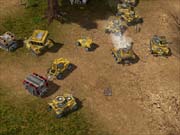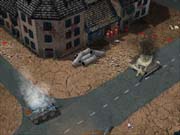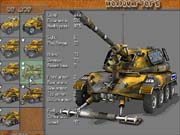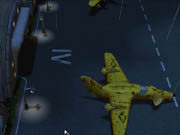The box cover for Stormregion's S.W.I.N.E. will be enough to give you an immediate impression about what to expect. There's a giant pig's face smoking a cigar and a line on the inside flap that reads "when good meat goes bad," which says a lot about the whimsical nature of the game. S.W.I.N.E. is actually a real-time tactical combat game that pits the war machines of the peaceful rabbits against those of the militaristic pigs. While the gameplay isn't quite as unusual as the premise, S.W.I.N.E. is a solid real-time strategy game with plenty of humor, all wrapped up in a beautiful shell.

The single-player mode of S.W.I.N.E. lets you play as either the rabbits or the pigs. It's recommended that you play as the rabbits first because the pig campaign is more challenging and immediately starts you off against the most powerful weaponry. The game offers clear objectives for each mission, although the whole premise seems strangely similar to the early events of World War II. The pigs aggressively attack the pacifist rabbits, who are unprepared to fight the more advanced weaponry of the pigs. The rabbits and pigs even speak with French and German accents, respectively, though these accents are so awful that it must have been a deliberate way of contributing to the ridiculous nature of the game. Add to that the fact that the buildings look like early-20th-century European architecture, and it's easy to draw a comparison between S.W.I.N.E. and WWII. Cutscenes attempt to contribute to the storyline, but most of the time you'll see video sequences that don't make much sense. They are amusing but are not really relevant to what's going on in the mission you just played.
As a real-time strategy game, S.W.I.N.E. plays very similarly to the games in the MechCommander series, or other sci-fi-themed tactical combat games such as Ground Control. There is no base building or resource gathering--instead you have a limited number of units in each mission. You're given a few units at the beginning of a campaign and can upgrade or purchase new units using "strategy points" awarded to you after every successful mission. You have an opportunity to buy new units before missions, but there's no real point to this because you can purchase them during the actual mission and have them delivered to any location. You'll quickly learn to use this latter option, since you'll never know what to expect from a mission until you're in the thick of it. For example, buying a minelayer on the fly after realizing you need to defend a location will make you glad you saved your strategy points. Strategy points are also used by command vehicles to call in air strikes. Using these powerful attacks as a last-ditch effort may mean the difference between success and failure.

You'll find that the rabbits and pigs have more in common than just bad voice acting. The two factions are virtually identical in terms of their units. This makes the pig campaign somewhat disappointing; playing as the opposing faction in other real-time strategy games is usually a welcome change of pace due to the availability of different units and the possibility of different strategies. Beyond that, the variety of units--at least within each side--is sufficiently good. You have light-caliber machine guns, vehicles, various tanks, artillery, rocket launchers, and other specialty units to play with. You not only have to keep track of your units' health, but also their ammo and fuel. Running out of either of these in the middle of a battle isn't going to make your day. Fortunately, you can purchase resource trucks to repair, refuel, and rearm your forces.
The artificial intelligence in S.W.I.N.E. makes for a good challenge throughout the single-player game. The computer doesn't actively seek you out, but that doesn't mean it will act passively when you encounter it. If you engage an enemy unit, any others in the vicinity will come to assist it in attacking you. Losing units can be absolutely catastrophic during these missions, so you had better scout an area thoroughly for hidden units or you'll have a group of enemy tanks attacking your artillery from the flank. The interface and pathfinding in S.W.I.N.E. are good, so you'll never have to worry about having to guide each and every unit through the rough terrain. There are also behavior settings to have your units hold position, chase after enemies, or retreat out of enemy firing range if engaged.
The most apparent weakness of the AI is that it won't go after priority units like artillery or repair trucks. Instead, it will usually attack the closest unit. The computer also won't chase after wounded units trying to flee. It's easy to just withdraw a damaged tank in the middle of a fight, repair it, and throw it back into the fray. These two factors can make the gameplay grow somewhat tedious as you find yourself doing the same thing over and over, capitalizing on the AI's poor tactics. Basically all you need to do in most instances is deploy your artillery, plant your main combat units in front to draw enemy fire, and you're all set. Sometimes you'll find that some enemy units won't move to attack you if you're hitting them outside their range.

Even if you do fall into a rut, at least you can spend that time admiring the graphics of S.W.I.N.E. Simply put, it is one of the best-looking real-time strategy games to date. The environments and textures are extremely detailed. Effects such as tumbleweeds rolling across the landscape and dust kicking up from moving vehicles are a great touch. The units themselves are also very detailed and nicely animated. You may get over the gorgeous graphics, but the animations will hold your attention much longer. Vehicles move like they would in the real world--they bounce over terrain and recoil when firing, and smoke billows from their gun barrels after firing a salvo. Tanks and other units with treads may be able to turn on a dime, but wheeled vehicles have to have some sort of turning radius or be forced to pull a K turn. It can be amusing to see a wheeled unit trying to move inside a tight group; it's reminiscent of the scene in Austin Powers when he tries to turn in the tight corridor. The maps themselves are huge and usually have several paths you can take to attack enemy defenses. Since the game uses a line-of-sight system for the fog of war, the giant cliffs and forests provide plenty of places to hide and set up ambushes.
Others factors contribute to the appeal of S.W.I.N.E. Although the voice acting may be bad, the rest of the sound isn't. Tanks and artillery sound as lethal as they should. Everything with an engine makes noise, so you can track down fleeing enemies even if their tracks disappear. The music is also enjoyable and fits the game nicely. Some missions also take place in different conditions, such as rain or nighttime, to help change the mood of the game.

Though the campaign missions are quite long and will keep you occupied for a while, you'll find the replay value of S.W.I.N.E. is limited. All the missions are scripted, so after your first attempt, you will always know where an enemy is hiding or where a patrol is headed. You can't really mix up your forces either, because you're definitely going to need certain units most every time, especially artillery to root out unreachable enemies. A skirmish mode is sorely missing from the game, so you also can't try out some of the more advanced units until you get to the later levels of the campaign. In addition, the program proved to be rather unstable on one of two test systems we tried it on. To help its lasting value, S.W.I.N.E. does include a multiplayer component that offers four different game modes: deathmatch, capture the flag, elimination, and countdown. You can try to find players to compete against using the integrated GameSpy service, but a lot of the S.W.I.N.E. servers are currently populated by Hungarian players, so you may encounter a language barrier trying to find some suitable competition. Besides that, we experienced bad lag trying to play the game online.
Though it isn't great in every respect, S.W.I.N.E. is a pleasant surprise for anyone who likes real-time strategy games. Many of its competitors are cookie-cutter games that either have sci-fi units or fantasy warriors and wizards. S.W.I.N.E. never attempts to take itself seriously, so it can be more enjoyable fighting its pigs or its rabbits rather than having to defend against invading aliens or the undead as per usual. S.W.I.N.E. is tailored for both RTS newcomers as well as experienced players looking for something different. The famous saying "Don't judge a book by its cover" doesn't apply here--in this case, you can do just that. S.W.I.N.E. is ultimately a fun and challenging game and can be recommended to anyone who enjoys the RTS genre but doesn't take it too seriously.